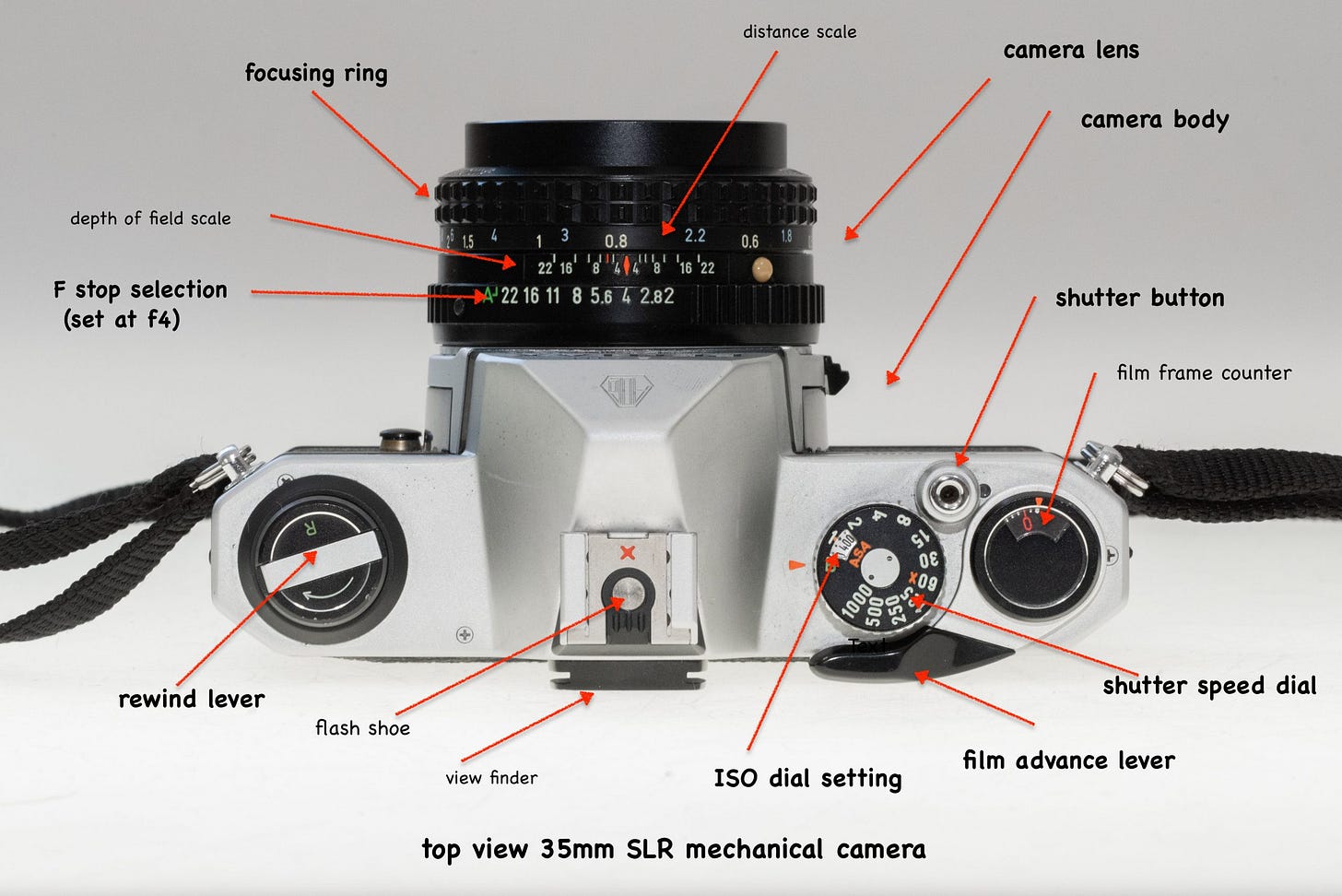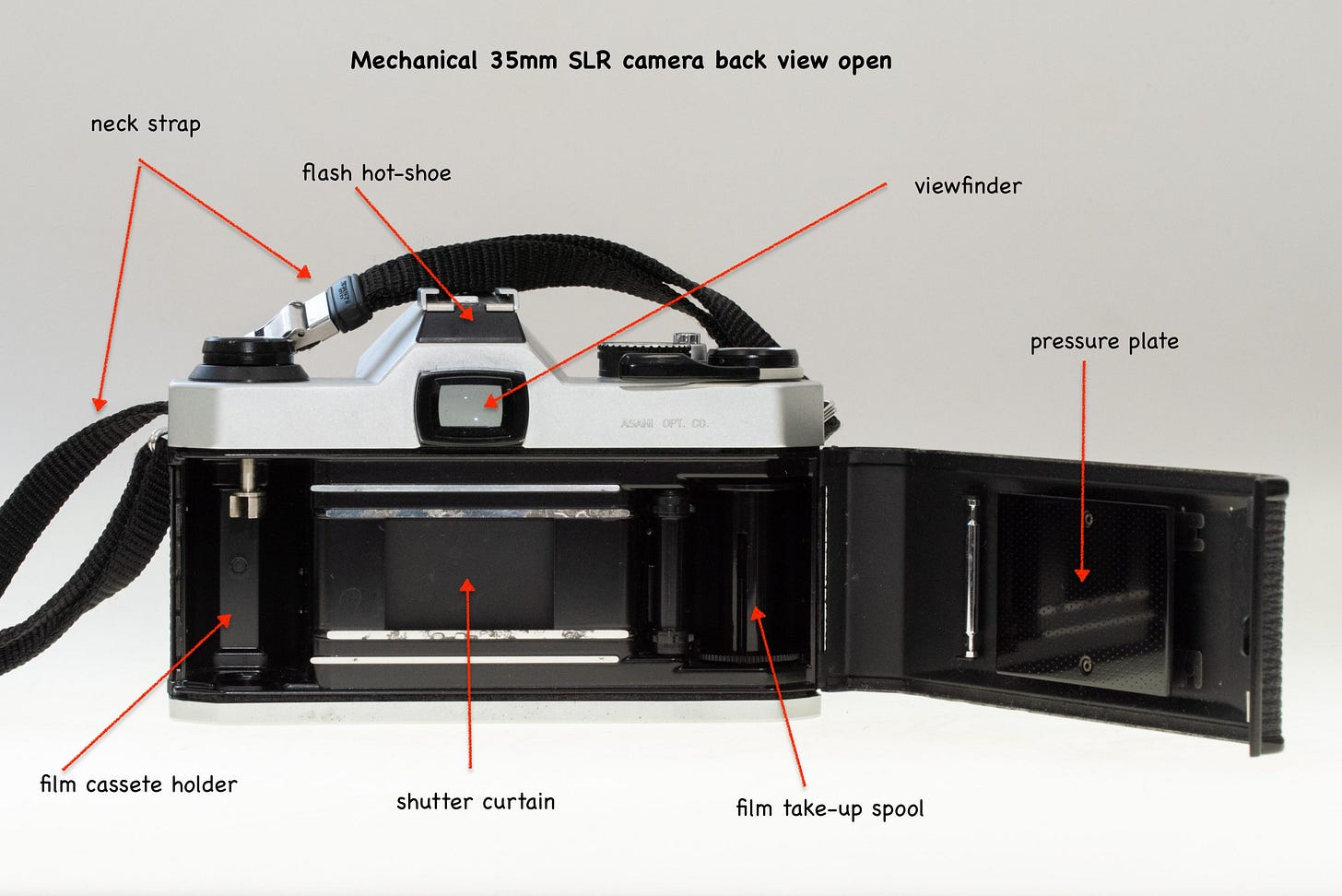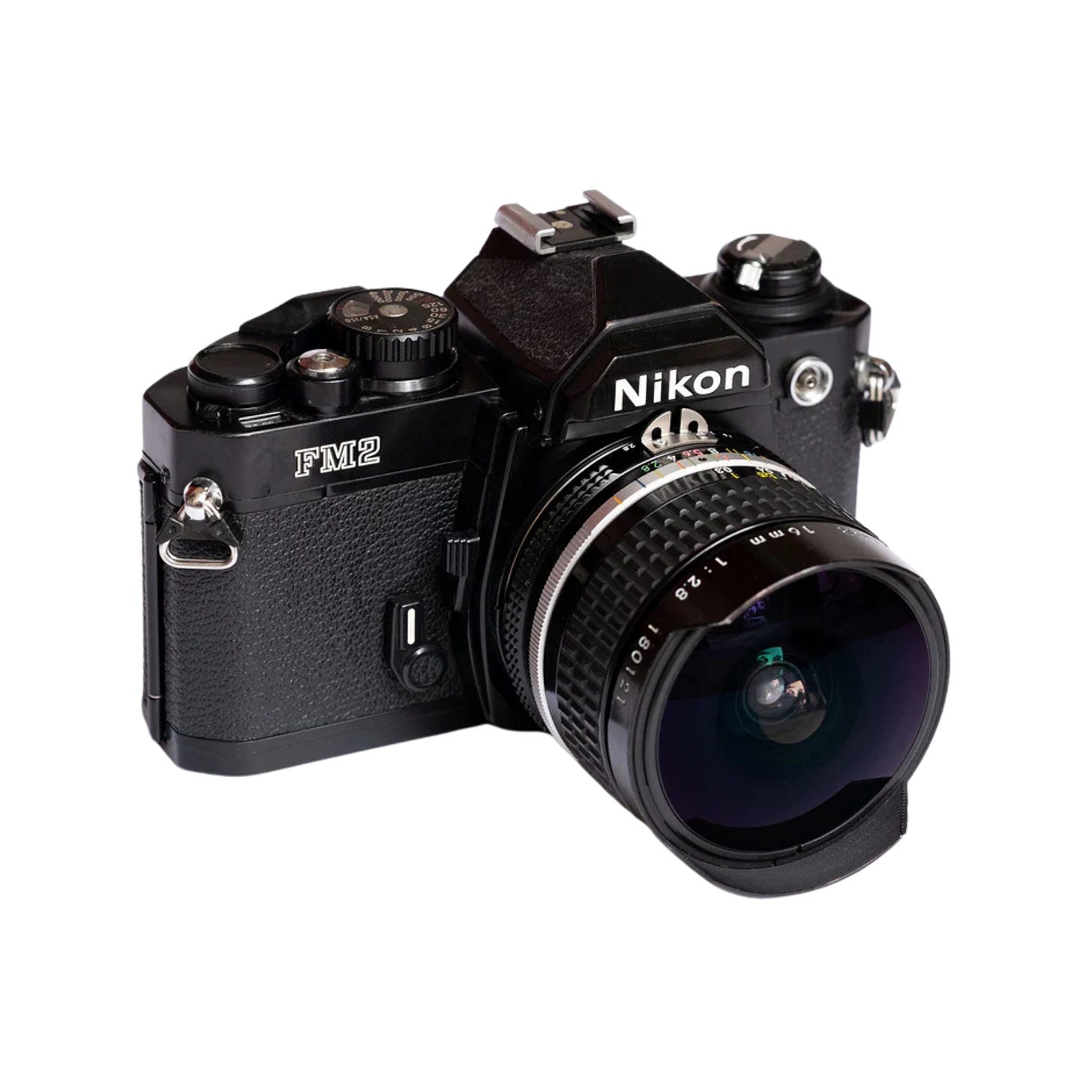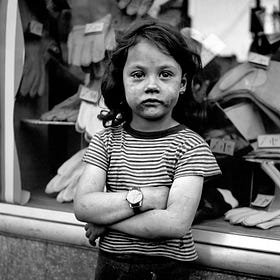How to Choose Your First Film Camera
Document your brightest moments and fill your house with cherished memories. Start your film photography journey here!
Before I could even apply to the competitive film program at my university, I had to complete several pre-requisites. Subjects ranged from communication and film theory to media writing. I found all of them deeply fascinating and informative but ART 250 (Photography I) was one of the most important classes to pass.
Beyond introducing camera and development techniques, the black-and-white film photography course was designed to provide a valuable darkroom experience. Unlike most students, I had zero experience with analog. And instant photography didn’t count.
I remember staring at the lengthy syllabus, wondering how I’d ever master the complex techniques and finish all the assignments with strict criteria. And then there was the pressure of walking away with an eye-catching portfolio for my application.
My journey started with researching 35mm film stocks and cameras. Fortunately, when it came to equipment, my professors and peers provided a wealth of knowledge. Most agreed that the Canon AE-1 Program was one of the best choices for beginners. When I found one on eBay in mint condition and within budget, I snapped it up (pun intended).
During the first few weeks, we covered the fundamentals: anatomy, metering, operation, exposure, compositional strategies, lab orientation, film processing, and of course, the invention of photography itself. The influx of information was simultaneously overwhelming and thrilling. It took several days before I truly felt comfortable, but I was determined to put in the work. This meant staying hours past class to research and practice.
When I developed my first roll of film, I couldn't contain my excitement. I jumped for joy, ironically taking a digital photo to commemorate the experience.
Subsequently, I printed a contact sheet, made selections, and finalized the prints for my first-ever assignment. Witnessing my images appear on crisp, light-sensitive photo paper was nothing short of magical. (In reality, the chemicals in the developer “turn the silver ions [on the paper] into silver metal;” when oxidized, they appear as dark shapes.1)
The process was time-consuming. I made mistakes and discarded several botched exposures. Though I “failed” far more than I succeeded, I cherished every second. And the results—those rare diamonds in the rough—were rewarding.
Upon completing the first project, I fell into a natural rhythm. Read, research, shoot, develop, print, and present. I was methodical, to say the least… Long after classes, I’d put on my headphones and retreat into the darkroom. Sometimes, 3 or 4 hours would pass by in a blink.
When I wasn't focused on the post-processing phase, I captured a variety of subjects. City streets, plants, cars, and people. My friends and family members became all too familiar with my trusty sidekick. The Canon AE-1 Program traveled with me everywhere.
Week by week, I gained more confidence and embraced experimentation. I started with dreamy in-camera effects like motion blur, softer focus, or long exposures. Later projects inspired me to create surreal, multiple exposures by stacking negatives in the darkroom.
Years later, I reflect on this period with such fondness. It reminds me that art takes time, and it’s always worth the sacrifice. I want everyone to experience the same sense of joy and discovery. You have the power to create extraordinary images.
Do you want to try film photography? I would start with understanding a camera’s basic functions.
BASIC FUNCTIONS
What is a film camera? It records images on a light-sensitive material. When the shutter is pressed, it opens for a fraction of a second—or sometimes longer—temporarily exposing the film to light. A lens influences the sharpness, depth of field, and perspective.
How is light controlled?
Aperture: the opening in a camera’s lens that allows light to pass
Shutter Speed: the length of time a camera shutter remains open
ISO (International Organization for Standardization): a numerical value that indicates a film roll’s sensitivity to light
Why are the camera body and lenses important? In addition to housing and protecting the film, the camera body contains a shutter and advance lever. The lens not only controls the amount of incoming light but also focuses the image onto the film.
Next, I would choose your camera type.
CAMERA TYPE
There are four different types of film cameras:
Single-Lens Reflex (SLR): An SLR camera uses a mirror and prism system, enabling photographers to preview what the lens will capture through the viewfinder. What you see is what you get. This feature is ideal for snapping portraits and action. SLRs also have faster shutter speeds, which provides more flexibility for shooting in a range of conditions. It’s important to note that they are larger, louder, and heavier than rangefinders. Due to the shutter recoil, photographers can only shoot handheld at higher shutter speeds (1/60 and above).
Rangefinder: Without a mirror system, rangefinders are lighter and far more resistant to camera shake. They also produce sharper images. Such qualities make them ideal for discreet street and travel photography. However, the viewfinder won’t ever show the lens’ true perspective. Plus, the max shutter speeds are slower, limiting aperture and depth-of-field controls.
Point-and-Shoot: Affordable point-and-shoot cameras with fixed lenses are designed for casual photography. Most if not all settings—including focus, exposure, shutter speed, and light sensitivity—are completely automated. In other words, a photographer’s creative freedoms are more limited.
Twin-Lens Reflex (TLR): Twin-Lens Reflex cameras have two objective, fixed lenses of the same focal length—one for composing and one for shooting. They most often utilize medium-format films like 120.
In this article, we will focus on the most common type: Single-Lens Reflex (SLR) beginner cameras. They are incredibly user-friendly and versatile!
BEGINNER CAMERAS
Vintage film cameras have the best builds. Designed with robust, mechanical components and metal frames, many have lasted decades. With several parts readily available, they are easier to repair than modern digital cameras characterized by complex electronics.
You can find retro models on marketplaces like eBay and Etsy. I recommend searching specialty camera stores like Cute Camera Co., Vintage Camera Hut, Sidekick Camera, or KEH.
Canon AE-1 (1976-1984)
Key Features:
Film speed: ISO 25 to 3200
Recording medium: 135 (35mm) film
Focus: Manual
Exposure: Manual shutter speeds and manual/automatic aperture
Shutter speed range: Bulb, 2 s to 1/1000 s
Other (+): Readily available, durable, reliable, user-friendly, affordable, excellent image quality, self-timer, compatible with a wide range of Canon FD lenses
Canon AE-1 Program (Introduced in 1981)
Key Features:
Film speed: ISO 12 to 3200
Recording medium: 135 (35mm) film
Focus: Manual
Exposure: Program (completely automatic), shutter priority, or manual
Shutter speed range: Bulb, 2 s to 1/1000 s
Other (+): Readily available, durable, self-timer, compatible with a wide range of Canon FD lenses
Minolta XD-11 in US (1977-1984)
Key Features:
Film speed: ISO 12–3200
Recording medium: 135 (35mm) film
Focus: Manual
Exposure: Shutter priority, aperture priority, or manual mode
Shutter speed range: Bulb, 1 s to 1/1000 s
Other (+): Affordable, world's first camera with a multi-mode exposure system, all-metal construction with a quality leatherette, excellent viewfinder, self-timer, depth of field preview, safe-load signal (indicating film is present and correctly spooled)
Olympus OM-10 (1979-1987)
Key Features:
Film speed: ISO 25 to 1600
Recording medium: 135 (35mm) film
Focus: Manual
Exposure: Automatic aperture-priority mode and optional manual adapter
Shutter speed range: Bulb, 1 s to 1/1000 s
Other (+): Compact, durable, lightweight, sharp kit lens, self-timer
Pentax K1000 (1976 to 1997)
Key Features:
Film speed: ISO 20–3200
Recording medium: 135 (35mm) film
Focus: Manual
Exposure: Fully manual with a built-in light meter
Shutter speed range: Bulb, 1 s to 1/1000 s
Other (+): Versatile choice, iconic workhorse beloved for its simplicity, all-metal body, operable without batteries
Nikon FM2 (1982 to 2001)
Key Features:
Film speed: ISO 12–6400
Recording medium: 135 (35mm) film
Focus: Manual
Exposure: Full manual operation and mechanical control
Shutter speed range: Bulb, 1 s to 1/4000 s
Other (+): Durable, reliable, compact, quintessential “backup camera” for many famous photographers, bright viewfinder, extremely fast shutter speed, operable without batteries, self-timer
*EXPENSIVE* Nikon F3 (1980 to 2002)
Key Features:
Film speed: ISO 12–6400
Recording medium: 135 (35mm) film
Focus: Manual
Exposure: Manual or aperture-priority mode
Shutter speed range: Time & Bulb, 8 s to 1/2000 s
Other (+): Trusted by pros for 20+ years, designed by Giorgetto Giugiaro (famed Italian automotive designer), sterling reputation for its extreme ruggedness, all-metal components, self-timer, double exposure lever, auto-exposure lock, mirror lockup (allows use of old fisheye and ultra-wide lenses), DOF preview button
Equipment is important, but it’s not everything. Photography is all about perspective. What story do you want to tell?
You don’t have to develop negatives and print your images. However, I highly recommend experiencing it at least once in your life.
Looking for inspiration from the greats? Read my article:
20 Inspiring Film Photographers
Before attempting 16mm shorts or long-format projects in film school, we had to understand and practice the fundamentals. Photography is one of them.
Do you have a favorite film camera? Which one would you try? Let me know in the comments below!
















